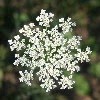 The wilderness park just north of Mt. Tremblant (Trembling Mountain) in the Laurentians is a wonderful place for nature walks and more strenuous hikes. In fact you can choose hikes from 1 hour long to over 24hrs long. You don't have to sleep walk - just pitch a tent and carry on the next day!
The wilderness park just north of Mt. Tremblant (Trembling Mountain) in the Laurentians is a wonderful place for nature walks and more strenuous hikes. In fact you can choose hikes from 1 hour long to over 24hrs long. You don't have to sleep walk - just pitch a tent and carry on the next day!I have done several of the shorter walks. My favourite is the 3hr walk around Lac des Femmes. When I decided to expand the Forest Scarves series, I just thought back to my trips around this lake. It is a very thickly forested area with lots of trees, hills, streams, ponds, ferns, flowers...the list goes on. It is a natural habitat for Blue Heron and White Tailed Deer to name just a few of the animals.

Pond Scarf is Lac des Femmes in lace. The lake, really more like a large pond, is fringed with reeds and dotted with water lilies. Spiders and beetles make lacey ripples on the blue, black surface of the water and loons call.
I chose Fantastic Knitting Zephyr lace weight in Blueberry for the colour, though the scarf could be knit in any number of colours from misty greys to lighter blues and golds. I simplified again a stitch that had patterning on the return row and it ended up looking quite like a lily pad. Pond scarf is worked a little like Fern Scarf in that it has a centre panel and side borders that form from a beginning rectangle. The rectangle stitch looks like the water spiders! I decided to finish the shawl with a lace stitch that resembled an organized tangle of reeds.
 There is something about the ecosystem of a pond that inspires awe. So many tiny microcosm each dependant on one another. Destroy one and the whole thing falls apart - like knitted lace - each stitch is so dependent on the other.
There is something about the ecosystem of a pond that inspires awe. So many tiny microcosm each dependant on one another. Destroy one and the whole thing falls apart - like knitted lace - each stitch is so dependent on the other.
Knit lace - be one with the natural world!



.jpg)











